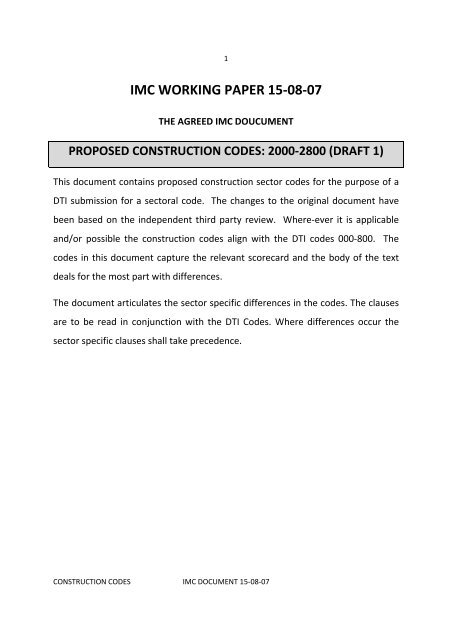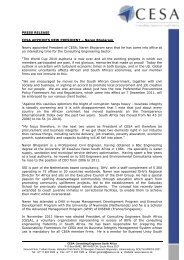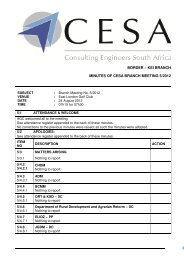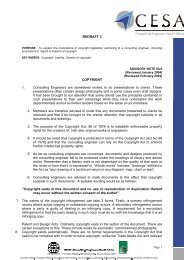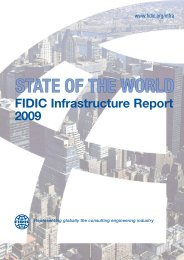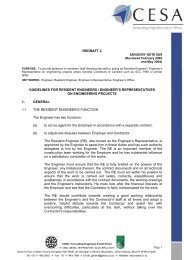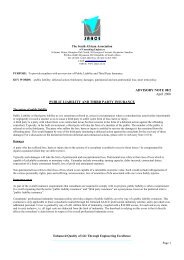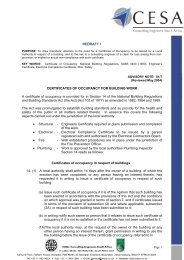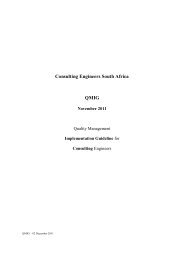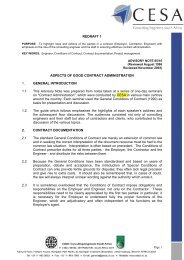IMC WORKING PAPER 15-08-07 - Cesa
IMC WORKING PAPER 15-08-07 - Cesa
IMC WORKING PAPER 15-08-07 - Cesa
You also want an ePaper? Increase the reach of your titles
YUMPU automatically turns print PDFs into web optimized ePapers that Google loves.
6Code Series 2100: Measurement of Ownership Element of Broad‐Based Black EconomicEmpowermentStatement 2100: The General Principles for Measuring Ownership1. The Ownership ScorecardCategory Ownership Indicator Weighting points Compliance Target1.1 Voting Rights:1.1.1 Exercisable Voting Rights in the Enterprise in the 4 30%hands of Black People1.1.2 Exercisable Voting Rights in the Enterprise in the 2 10%hands of Black Women1.2 Economic Interest1.2.1 Economic Interest of Black People in the Enterprise 5 30%1.2.2 Economic Interest of Black Women in the Enterprise 2 10%1.2.3 Economic Interest of the following Black NaturalPeople in the Enterprise:5 10% Contractors5% BEP’s1.2.3.1 Black designated groups;1.2.3.2 Black Participants in Employee OwnershipSchemes;1.2.3.3 Black Beneficiaries of Broad Based OwnershipSchemes;1.2.3.4 Black Participants in Co‐operatives1.3 Realisation Points1.3.1 Ownership fulfillment 1 Refer to paragraph10.1, Code 100, P281.3.2 Net Value 6 Refer to Annexe Cparagraph 4, Code100, P33 and Noteson Calculations inCode 21002. Notes on Calculationsa. The Net Value calculation referred to in Annexe C, Code 100 above: A=B x (1/ (30% x C)) x 6 (6 isthe weighting attributed to this indicator).3. Code 100a. Code 2100 shall adhere to all other principles, definitions and measurement methodologiescontained in Code 100, Annexes and related Statements as published in the GovernmentGazette no. 29617 and where there are any conflicts, the requirements of code 2100 shalltake precedence over code 100 as published in the Government Gazette No 29617.CONSTRUCTION CODES <strong>IMC</strong> DOCUMENT <strong>15</strong>‐<strong>08</strong>‐<strong>07</strong>
7Code Series 2200: Measurement of the Management Control Element of Broad‐BasedBlack Economic EmpowermentStatement 2200: The General Principles for Measuring Management Control1. The Management Control ScorecardCategory Management Control Indicator Weighting Points Compliance Target1.1 Board Participation:1.1.1 Exercisable Voting Rights of Black Board 5 40%Members using the Adjusted Recognition for Gender1.2 Top Management:1.2.1 Black Senior Top Management using theAdjusted Recognition for Gender5 25% (Year 0‐4)40% (Year 5‐7))2. Notes on Calculationa. The Adjusted Recognition for Gender in Annexe 200(A), Code 200 will be applied asfollows in Code 2200 (The reference to the letters remains the same as in Annexe200(A), P48):i. 1.1.1 A=B/1.76+Cii. 1.2.1 A=B/1.62+Cb. Other Top Management as referred to in Code 200 that is at a higher level ofManagement in the Measured Entity than what is associated with the definition ofSenior Management must be counted as part of the Senior Top Management.c. The indication: “C is limited to a maximum of 50% of the target” in Annexe 200(B), Code200, P49 is not applicable. The rest of the references in Annexe 200(B) apply.d. The responsibilities associated with executive and non‐executive directors on the boardare viewed to be similar.3. Code 200a. Code 2200 shall adhere to all other principles, definitions and measurementmethodologies contained in Code 200, Annexes and related Statements as beenpublished in the Government Gazette no. 29617 and where there are any conflicts, therequirements of code 2200 shall take precedence over code 200 as published in theGovernment Gazette No 29617.CONSTRUCTION CODES <strong>IMC</strong> DOCUMENT <strong>15</strong>‐<strong>08</strong>‐<strong>07</strong>
93. The Charter Council will inter alia monitor the representation of black people with disabilities inthe sector.4. For verification purposes a person can be seen as disabled should that person not be in aposition to compete with his/her peers without reasonable accommodation. Therefore should aperson wish not to declare their disability in terms of Employment Equity reporting, that personcan be viewed as disabled should the above guideline be applicable.5. Code 300a. Code 2300 shall adhere to all other principles, definitions and measurementmethodologies contained in Code 300, Annexes and related Statements as beenpublished in the Government Gazette no. 29617 and where there are any conflicts, therequirements of code 2300 shall take precedence over code 300 as published in theGovernment Gazette No 29617.CONSTRUCTION CODES <strong>IMC</strong> DOCUMENT <strong>15</strong>‐<strong>08</strong>‐<strong>07</strong>
10Code Series 2400: Measurement of Skills Development Element of Broad‐Based BlackEconomic EmpowermentStatement 2400: The General Principle for Measuring Skills Development1. The Skills Development ScorecardCategory Skills Development Element Weighting Points ComplianceContractors BEP Target1.1 Skills Development Expenditure on any program specified in the Learning Programmes Matrix (Code400, P57)1.1.1 Skills Development Expenditure on all 2 2.5 1.5%employees as a percentage of Leviable Amount.1.1.2 The portion of Skills Development3 4 70%Expenditure, spent on Black Employees, as apercentage of Skills Development Expenditure onall employees using the Adjusted Recognition forGender1.1.3 The portion of Skills Development1.5 2 25%Expenditure, spent on Black Employees in allManagement Categories, as a percentage of theportion of Skills Development Expenditure spenton Black Employees, using the AdjustedRecognition for Gender. (See paragraph 1.b)1.2 Learnerhips1.2.1 Number of Learners participating inLearnerships or Category B, C and D programmes1 1.5 2.5% Contractors1.5% BEP’sas a percentage of total employees. (Seeparagraph 1.c)1.2.2 Black Learnership and/or Black Category B, 2.5 3.5 70%C and D programme participants as a percentageof total Learnerships and Category B, C and Dprogramme participants using the AdjustedRecognition for Gender1.2.3Black People with disabilities participating in 1 1.5 5%Learnerships and/or Category B, C and Dprogrammes as a percentage of BlackLearnerships and Black Category B, C and Dprogramme participants using the AdjustedRecognition for Gender. This Item only applies tooffice based employees. (See paragraph 1.d)1.3 Bursaries1.3.1 Scholarship and/or Bursary Expenditure onBlack Students, as a percentage of LeviableAmount2 2.5 0.3%1.4 Mentorship1.4.1 Implementation of an approved andverified mentorship programme (paragraph 3)2 2.5 Yes to all criteriain paragraph 3CONSTRUCTION CODES <strong>IMC</strong> DOCUMENT <strong>15</strong>‐<strong>08</strong>‐<strong>07</strong>
111. Notes on Calculationsa. The Adjusted Recognition for Gender in Annexe 400(B), Code 400 will be applied as follows inCode 2400 (The reference to the letters remains the same as in Annexe 400(B), P58):i) 1.1.2 A=B/1.2+Cii) 1.1.3 A=B/1.71+Ciii) 1.2.2 and 1.2.3 A=B/1.29+Cb. S = D/E * W (Calculation for 1.1.3)i) S = The score applicable to this indicator. Black Management includes all levels of management.ii) D = [(The portion of Skills Development Expenditure spent on Black Management divided by theportion of Skills Development Expenditure spent on Black People) /1.71] + (The portion ofSkills Development Expenditure spent on Black Female Management divided by the portionof Skills Development Expenditure spent on Black People). Multiply the result of thecalculation with 100 to express in a percentage format.iii) E= The target for this indicator (25%).iv) W= The weight of this indicator.c. Total employees for the purpose of the calculation in paragraph 1.2.1 refer to the averagenumber of employees over the measurement period. It does not refer to the total number at aparticular point during the measurement period.d. V=Y/Z*X (Calculation for 1.2.3)i) V=The score applicable to this indicator.ii) Y=[(The number of Black People with disabilities participating in Learnerships and/or Category B,C and D programmes divided by the number of Black Learnerships and Black Category B, Cand D programme participants that form part of or will form part of office basedstaff)/1.29]+ (The number of Black Females with disabilities participating in Learnershipsand/or Category B, C and D programmes divided by the number of Black Learnerships andBlack Category B, C and D programme participants that form part of or will form part ofoffice based staff). Multiply the result of the calculation with 100 to express in a percentageformat.iii) Z= The target for this indicator (5%).iv) X= The weight of this indicator.CONSTRUCTION CODES <strong>IMC</strong> DOCUMENT <strong>15</strong>‐<strong>08</strong>‐<strong>07</strong>
12e. Calculations only relate to employees of the measured entity with the exception of the provisionof 1.f.f. Bursary related costs that can be included are limited to students that are currently employed orcontractually obliged to work for the Measured Entity in the future. Furthermore this indicatorwill be subject to the same provision contained in paragraph 3.2, Code 400, P 55g. The review of targets related to Learnerships as indicated in paragraph 5.4.4 in the Section 12Construction Transformation Charter will take place three years after the commencement dateof this Statement.2. Code 400a. Code 2400 shall adhere to all other principles, definitions and measurement methodologiescontained in Code 400, Annexes and related Statements as been published in the GovernmentGazette no. 29617 and where there are any conflicts, the requirements of code 2400 shall takeprecedence over code 400 as published in the Government Gazette No 29617.3. Mentorshipa. Measurement of Mentoringi) Compare the company mentor program with the provided list of criteria. If the programcomplies with the list of requirements below, it will qualify for recognition in the score card.ii) The verification agent will evaluate the portfolio of evidence for the protégés against the listprovided.iii) The verification agent will randomly select a few protégés to interview to determine theeffectiveness of the program.iv) The verification agent will then sign off that the mentor program is compliant.b. The following criteria constitute a mentor program and must be present in the Measured Entityi. Each company must have one person in the company who is responsible and accountable formentoring, called the mentor champion. In a larger company, this may be the chairman of acommittee set up to manage a mentor program.ii. Other criteria for the program include the following:1. The objectives and desired outcomes of the program2. The structure of the program3. The resources required and how they will be allocated4. Methods on how the protégés and mentors will be selected and matchedCONSTRUCTION CODES <strong>IMC</strong> DOCUMENT <strong>15</strong>‐<strong>08</strong>‐<strong>07</strong>
135. The training for the mentors and protégés on their responsibilities toward the mentorrelationship, which may include communication skills and conflict handling6. The training necessary to support the mentoring7. The time frames for the implementation of the programiii. General portfolio of evidence to include the following1. Monthly to mentor champion on overall program (Internal progress review)2. CV of mentor champion3. Minutes of mentor committee meetings4. Plan of mentor program as indicated aboveiv. Individual portfolio of evidence for each protégé to include the following:1. Minutes of meetings between protégés and their mentors including details of time,location and duration of meetings, topics discussed advice and guidance given andprogress review on required development outcomes.2. Any training provided to support protégé development3. Attendance at mentor and protégé training for the program4. Individual development plan5. Development interventions6. Quarterly report on protégé benefits from mentor relationship7. Individual progress review on a quarterly basis against individual development plan8. Activities undertaken by the protégé including which departments the protégéworked in, details of job assignments and details of activities undertaken.CONSTRUCTION CODES <strong>IMC</strong> DOCUMENT <strong>15</strong>‐<strong>08</strong>‐<strong>07</strong>
14Code Series 2500: Measurement of Preferential Procurement Element of Broad‐Based BlackEconomic EmpowermentStatement 2500: The General Principle for Measuring Preferential Procurement1. The Preferential Procurement ScorecardCriteriaWeighting Compliance TargetsPoints1.1 B‐BBEE Procurement Spend 0‐4 Years 5‐7 Years1.1.1 B‐BBEE Spend on all Suppliers based on the B‐BBEE 12 50% 70%Procurement Recognition Levels as a Percentage of TotalProcurement Spend1.1.2 B‐BBEE Procurement Spend from Qualifying Small 3 10% <strong>15</strong>%Enterprise or Exempted Micro Enterprise based on theapplicable B‐BBEE Procurement Recognition Levels as apercentage of Total Measured Procurement Spend1.1.3B‐BBEE Procurement Spend from any of the followingSuppliers as a percentage of Total Measured ProcurementSpend:1.1.3.1 Suppliers that are 50% black owned. 3 9% 12%1.1.3.2 Suppliers that are 30% black women owned. 2 6% 8%2. Code 500a. In addition to the exclusion listed in Code 500, the BEP’s will be permitted to excludecurrent facility rental contracts. This relaxation will be for contracts signed before the1 st of November 2005 and will be for a maximum period of the current contract and willexclude any extended and or altered contract conditions.b. Code 2500 shall adhere to all other principles, definitions and measurementmethodologies contained in Code 500, Annexes and related Statements as beenpublished in the Government Gazette no. 29617 and where there are any conflicts, therequirements of code 2500 shall take precedence over code 500 as published in theGovernment Gazette No 29617.CONSTRUCTION CODES <strong>IMC</strong> DOCUMENT <strong>15</strong>‐<strong>08</strong>‐<strong>07</strong>
<strong>15</strong>Code Series 2600: Measurement of Enterprise Development Element of Broad‐Based BlackEconomic EmpowermentStatement 2600: The General Principle for Measuring Enterprise Development1. Enterprise Development (ED) ScorecardCriteria Weighting Points ComplianceContractors BEP’s Target1.1 Enterprise Development Program1.1.1 Compliance with the Requirements and Guidelines foran Enterprise Development Program (paragraph 2 and 3) forat least one recipient. The Measured Entity must submit anannual portfolio of proof indicating compliance with the prerequisitesas well as adherence to the Guidelines for anEnterprise Development Program.5 5 Yes to allprogramrequirementsand prerequisites1.2 Enterprise Development Contributions1.2.1Average annual value of all Enterprise DevelopmentContributions and Sector Specific Programmes made by theMeasured Entity as a percentage of NPAT/Leviable Amount.10 5 3% of NPAT(Contractor)0.75% ofLeviableAmount (BEP)2. Pre‐requisites for an Enterprise development Relationshipa. A relationship agreement of co‐operation and assistance has to be in place between theestablished organization (EO) and developing organisation (DO).b. The EO may not have an equity holding larger than 20% in the DO, either directly orthrough a flow through calculation.c. The DO that can qualify for Enterprise Development must:i. be a legal entity compliant with SA Revenue Service requirements;ii. be an employer of at least three other permanently employed personnel andnot merely a one person operation with temporary employees.iii. Must be 50% or more black owned or 30% or more black women owned.3. Requirements for Enterprise Development Programa. The Measured Entity must have proof of compliance with the following fiverequirements before the relationship with a potential recipient of enterprisedevelopment will be labeled as an official enterprise development relationship attachedto the Measured Entity (and points will be allowed for this indicator):CONSTRUCTION CODES <strong>IMC</strong> DOCUMENT <strong>15</strong>‐<strong>08</strong>‐<strong>07</strong>
17for activities i‐iv for submission to a verification agent at the end of themeasurement period.4. Process of verification related to the Enterprise development Program in order to allocate 5points (points allocated on all or nothing basis).a. Verification Agents will:i. Ensure that all the pre‐requisites for an Enterprise Development Relationshiphave been met over the period of measurement in order to recognize theEnterprise Development Program.ii. Ensure that the Enterprise Development Program complies with therequirements.iii. Interview the DO owner and selected staff to verify Enterprise DevelopmentProgram claims.5. Focus on Developing Organisations:a. The focus on ED should be on the development of entities in the construction sector andperiphery. Examples are as follows (but not limited to):i. Suppliers – suppliers of construction equipment, construction materials, hiredplant/machinery and formwork and the like e.g. stationary, cleaning materials,electronic equipment etc.ii. Professional service providers – auditing and financial service providers, legalservices, services in the built environment professionals (architects,environmental consultants, engineering consultants, quantity surveyors, townplanners, land surveyors, geologists, material testing laboratories) and otherspecialist consultants etc.iii. Built environment service providers – contractors, (building, interior decorators,painting, civil, mechanical, electrical and electronic) specialist sub contractors.(Geotech, piling, asphalt, landscaping, fencing, road marking)6. Notes on Calculation related to paragraph 1.2a. Code 2600 shall adhere to all other principles, definitions and measurementmethodologies contained in Code 600, Annexes and related Statements as beenpublished in the Government Gazette no. 29617 and where there are any conflicts, theCONSTRUCTION CODES <strong>IMC</strong> DOCUMENT <strong>15</strong>‐<strong>08</strong>‐<strong>07</strong>
19Code Series 2700: Measurement of Socio Economic Development Element of Broad‐BasedBlack Economic EmpowermentStatement 2700: The General Principle for Measuring Socio Economic Development1. Socio Economic Development ScorecardCriteria Weighting Compliance TargetAverage annual value of all Socio Economic DevelopmentContributions by the Measured Entity as a percentageNPAT/Leviable Amount.5 1% of NPAT(Contractor)0.25% of LeviableAmount (BEP)1. Due to the limited absorption capacity of disabled employees by the sector the following twoitems are added to the Benefit Factor Matrix, Annexe 700(A), P76 of the Codes published in theGovernment Gazette no. 29617:a. In kind expenditure related to existing building and infrastructure facilities byContractors to ensure accessibility to people with disabilities in line with universaldesign principles. The full cost of the modifications done in kind with a benefit factor of1<strong>15</strong>%.b. Consultation, in kind, with associations/NGO’s relevant to people with disabilities toensure that the designs of new as well as existing public infrastructure comply withuniversal design principles. The full amount of the time cost with a benefit factor of1<strong>15</strong>%.2. Code 700a. Code 2700 shall adhere to all other principles, definitions and measurementmethodologies contained in Code 700, Annexes and related Statements as beenpublished in the Government Gazette no. 29617 and where there are any conflicts, therequirements of code 2700 shall take precedence over code 700 as published in theGovernment Gazette No 29617.CONSTRUCTION CODES <strong>IMC</strong> DOCUMENT <strong>15</strong>‐<strong>08</strong>‐<strong>07</strong>
20Code Series 2800: Codes of Good Practice for Qualifying Small Enterprises (QSE’s)Statement 2800: The Framework for the QSE Scorecard1. The QSE Scorecarda. Eligibility for a QSE as articulated in paragraph 4 Statement 2000.b. There are no bonus point allocations in the QSE scorecard or sub‐minimum requirements.c. Code 2800 shall adhere to all other principles, definitions and measurement methodologiescontained in Code 800, Annexes and related Statements as been published in theGovernment Gazette no. 29617 and where there are any conflicts, the requirements of code2800 shall take precedence over code 800 as published in the Government Gazette No29617.2. Statement 2801: Ownership for QSE’sa. The QSE Ownership ScorecardCategory Ownership Indicator Weighting Points Compliance Target2.1 Voting Rights2.1.1 Exercisable Voting Rights in the 4 30%Enterprise in the hands of Black People2.1.2 Exercisable Voting Rights in the 2 10%Enterprise in the hands of Black Women2.2 Economic Interest2.2.1 Economic Interest of Black People 8 30%in the Enterprise2.2.2 Economic Interest of Black Women 4 10%in the Enterprise2.3 Realisation Points2.3.1 Ownership fulfillment 12.3.2 Net Value 6b. Notes on Calculationi. The Net Value calculation is applied as in Code 2100.ii. A minimum score of 6 points for Net Value is a requirement for the award of theOwnership Fulfillment point.iii. All principals defined in Code 2100 and Statement 801 apply to Code 2801CONSTRUCTION CODES <strong>IMC</strong> DOCUMENT <strong>15</strong>‐<strong>08</strong>‐<strong>07</strong>
213. Statement 2802: Management Control for QSE’sa. The QSE Management Control ScorecardCategory Management Control Indicator Weighting Points Compliance Target3.1 Top Management3.1.1 Black representation at Senior Top‐Management Level using the AdjustedRecognition for Gender25 25% (0‐4 Year)40% (5‐7 Year)All principals defined in Code 2200 and Statement 802 apply to Code 2802The Adjusted Recognition for Gender must be applied as in paragraph 1.2.1 of Code 2200.4. Statement 2803: Employment Equity for QSE’sa. The QSE Employment Equity ScorecardCriteriaBlack Employees of the Measured Entity within allManagement Categories as a percentage of allEmployees in the Management Categories adjustedusing the Adjusted Recognition for GenderBlack Employees of the Measured Entity as apercentage of all employees adjusted using theAdjusted Recognition for Gender.Weighting Compliance TargetsPoints Years 0 ‐ 4 Years 5 ‐ 7<strong>15</strong> 30% 40%10 60% (Contractors)40% (BEP’s)70% (Contractors)50% (BEP’s)All principals defined in Code 2300 and Statement 803 apply to Code 2803The Adjusted Recognition for Gender must be applied as in paragraph 1.1.2 of Code 2300.5. Statement 2804: Skills Development for QSE’sa. The QSE Skills Development ScorecardSkills Development Element Weighting Points Compliance Target5.1 Skills Development Expenditure in respect of all 10 1.5%employees on learning programmes as a percentageof Leviable Amount5.2 The portion of Skills Development Expenditure,spent on Black People, expressed as a percentage oftotal Skills Development Expenditure using theAdjusted Recognition for Gender.<strong>15</strong> 70%All principals defined in Code 2400 and Statement 804 apply to Code 2804The Adjusted Recognition for Gender must be applied as in paragraph 1.1.2 of Code 2400.CONSTRUCTION CODES <strong>IMC</strong> DOCUMENT <strong>15</strong>‐<strong>08</strong>‐<strong>07</strong>
226. Statement 2805: Preferential Procurement for QSE’sa. The QSE Preferential Procurement ScorecardCriteria Weighting Points Compliance TargetBEE Procurement Spend from all Suppliers based onthe BEE Procurement Recognition Levels as apercentage of Total Measured Procurement Spend25 40% (0‐4 Year Target)50% (5‐7 Year Target)All principals defined in Code 2500 and Statement 805 apply to Code 28057. Statement 2806: Enterprise Development for QSE’sa. The QSE Enterprise Development (ED) ScorecardCriteriaAverage annual value of all Enterprise DevelopmentContributions and Sector Specific Programmes madeby the Measured Entity as a percentage ofNPAT/Leviable Amount. All aspects of Code 600 arerelevant to this indicator.Weighting Compliance TargetPoints25 2% of NPAT (Contractor)0.5% of Leviable Amount (BEP)All principals defined in Code 2600 and Statement 806 apply to Code 28068. Statement 28<strong>07</strong>: Socio‐Economic Development Contributions for QSE’sa. The QSE Socio‐Economic Development (SED) ScorecardCriteriaAverage annual value of all SED contributions andapproved SED contributions made by the measuredentity as a percentage of NPAT/Leviable Amount.All principals defined in Code 2700 and Statement 8<strong>07</strong> apply to Code 28<strong>07</strong>Weighting Compliance TargetPoints25 1% of NPAT (Contractor)0.25% of Leviable Amount (BEP)CONSTRUCTION CODES <strong>IMC</strong> DOCUMENT <strong>15</strong>‐<strong>08</strong>‐<strong>07</strong>
23Interpretations and DefinitionsPart 1: InterpretationThe Codes 2000‐2800 related to the Construction Sector shall be interpreted according to the sameprovisions as provided for in the Interpretation section, P87 of Government Gazette No. 29617.Part 2: DefinitionsAll definitions will apply to Codes 2000‐2800 related to the Construction Sector as it appear in theDefinition section, P87‐93 of Government Gazette No. 29617, read with the definitions listed below:BEPContractorConstruction ActivitiesConstruction SectorUnincorporated Joint VentureManagementBuilt Environment Professional related enterpriseswhich provide services related but not limited toconsulting engineering, architecture and quantitysurveying.Construction enterprise involved in theConstruction Sector.The design, planning, expansion, creation and/ormaintenance of fixed assets related to residentialor non‐residential buildings, infrastructure, or anyother form of construction works in South Africa.All enterprises that are involved in the design,planning, expansion, creation and/or maintenanceof fixed assets related to residential or nonresidentialbuildings, infrastructure, or any otherform of construction works in South Africa. Thisincludes, but is not limited to: residential and nonresidentialbuilding contractors, civil engineeringcontractors and built environment professionals.Means a Joint Venture between two or moreMeasured Entities affected by agreement withoutincorporation. This is a joint venture normallyformed ad‐hoc for a specific project, in which twoor more parties share the obligations, risks andrewards.Senior Management Category:The heads of major functions not represented onthe main board and within Senior TopManagement and who are responsible foroperational decisions.Middle Management Category:CONSTRUCTION CODES <strong>IMC</strong> DOCUMENT <strong>15</strong>‐<strong>08</strong>‐<strong>07</strong>
24Middle management reporting to Seniormanagement category, professionally qualifiedemployees and experienced specialists.Junior Management Category:The skilled technical & academically qualifiedemployees, junior management reporting tomiddle management, supervisors, foremen andsuperintendents.MentorshipThe process of assisting employees to gain furtherknowledge, experience and skills; it is an activitythat can be successfully used where senioremployees develop junior employees within acompany to enhance their career development.Office Based EmployeesAll staff who are based at the office. Generally thiscategory of staff will be head‐office staff in acontracting company. For BEP’s it excludes staffthat visits construction sites.Where there are any contradictions these definitions shall take precedenceCONSTRUCTION CODES <strong>IMC</strong> DOCUMENT <strong>15</strong>‐<strong>08</strong>‐<strong>07</strong>
25Substantiating DocumentationIntroductionThe Construction Sector is a priority sector under the Department of Public Works and facilitates newfixed investment as well as the maintenance of existing infrastructure. In many instances the Sector isresponsible for the creation of public goods like roads, airports, harbors and basic services. As a resultof the nature of its activities the Sector interacts with Government on a daily basis through amongstother tendering procedures and as a result is subjected to Public Sector Procurement Policies.Resulting from the provision of public goods the Sector is continually under close scrutiny to ensureprudent spending of tax payer’s money. The Sector is also viewed as a strong employment creator. Inaddition to being first tier suppliers to Government it has an extended supplier base consisting ofcompanies within the sector (sub‐contractors) as well as various other sectors, which enable the Sectorto exert considerable pressure down the supply chain.With the above in mind the Sector developed a Sector Transformation Charter, which has beenapproved under Section 12 of the Broad Based Black Economic Empowerment Act 53 of 2003. It ishowever crucial that the Sector develop a Sector Code of Good Practice, which aligns with the GenericCode of Good Practice but retain Sector specific peculiarities. In this regard it is important to look atproposed Construction Codes within the context of the challenges faced by the sector.Sector DynamicsThe fragmented nature of the sector required that numerous major stakeholders participated in thedevelopment of the proposed Construction Codes. These stakeholders, their role and level of input inthe process were articulated in the Section 12 application. It has been a process with distinct challengesand the targets and weightings agreed as a result carry with it the emotional buy in which can beassociated with a negotiation process spanning several years. It has resulted in much greater cohesion,a sense of identity and a hope for greater ownership of transformation initiatives within the sector.The ProcessThe Section 12 Sector Transformation Charter was published in the government gazette in February20<strong>07</strong>, the same day the Department of Trade and Industry Codes of Good Practice were published.Though not a prescript in the latest version of the Generic Codes, the Construction Sector decided toCONSTRUCTION CODES <strong>IMC</strong> DOCUMENT <strong>15</strong>‐<strong>08</strong>‐<strong>07</strong>
28requirement of providing an incentive for training and development of professionalsinvolved in the consulting engineering field, quantity surveying and architecture. Thelesser emphasis on Enterprise Development is as a result of the nature of the businessesoperating in the industry which in most cases require affiliation with professional bodiesand a particular tertiary development before one can practice. The majority of entitiesin these disciplines are smaller practices with the same background hence limited abilityto promote this element aggressively.Code 20001. The scope of application is defined to ensure correct application of the Constructioncodes.2. The Contracting fraternity aligns with the parameters of Exempted Micro Enterprisesand Qualifying Small Enterprises as it appears in the DTI Codes. The BEP’s have lowerparameters as a result of being a services oriented industry with much lower annualturnover than the Contracting fraternity. This is to ensure a proper mix of applicationdue to the fact that 90% of enterprises in this industry fall under the upper parameter ofR35 million.3. An unincorporated joint venture is a common project specific occurrence in the sector.In this regard a weighted combination of scorecards for tendering purposes inaccordance with the shareholder agreement is proposed. This will deter fronting in thesector. The proposal only applies to unincorporated joint ventures and once a separatelegal entity is formed it will require its own scorecard.4. The Construction Codes will have a transitional phase in line with the calculationmethodology proposed in the DTI codes. A different factor is required due toOwnership having a higher weighting than the DTI Codes.Code 2100: Ownership1. The Ownership element in the Construction Codes aligns exactly with the definition ofbeneficiaries, calculation methodology and format.CONSTRUCTION CODES <strong>IMC</strong> DOCUMENT <strong>15</strong>‐<strong>08</strong>‐<strong>07</strong>
30construction sector attended negotiations and made a strong case for higher levels ofrepresentation. However in the light of status quo they agreed to the specific targetsfor black women in relation to black people as they appear in the Section 12 Charter.Hence though the Construction Codes adopted the Adjusted Recognition for Genderprinciple the denominator used reflect the agreed ratio, which is lower than 50% asproposed by the DTI Codes. This approach applies to all areas where the AdjustedRecognition for Gender has been applied.3. Board participation in the Construction Codes does not distinguish between Executiveand Non‐Executive directors, which according to the King Report share equalresponsibilities in line with good corporate governance. The fact that the ConstructionCharter does not have any bonus points also disallow for recognition of any nonexecutivedirectors related to the board (as it appears in the DTI Codes). It is also theview that control is influenced by voting rights. The amount of executive directors isirrelevant to control as more than 50% voting could be held by an individual. This couldprejudice existing black owned Measured Entities.4. Top management and related definitions were accepted in the Construction Codes.The ultimate target of 40% equals that of the DTI Codes, though an interim target wasapproved by the Minister of Public Works in the light of the shortage of technicallyskilled people in the field. The Adjusted Recognition for Gender principle is applied. Theweighting attributable is 5, as this element contains all management higher than SeniorManagement. In effect it constitutes the same requirement as the DTI Codes. The factthat a large percentage of companies in the sector would be confused by thehierarchical levels proposed in the DTI Codes including Board, Top, Other Top, Senior,Middle and Junior management led to the exclusion of Other Top management forsimplicity sake (without compromising on the intent).Code 2300: Employment Equity1. The element weighting for Employment Equity is 5 points lower than in the DTI Codes,which inevitably has a bearing on the comparative indicator weightings.2. The same calculation methodologies have been adopted related to the AdjustedRecognition for Gender (aligned with agreed ratios). Please see: Needs and Numbers,CONSTRUCTION CODES <strong>IMC</strong> DOCUMENT <strong>15</strong>‐<strong>08</strong>‐<strong>07</strong>
31written by Allyson Lawless and Published by the South African Institute of CivilEngineering, Chapter 7, P163. In South Africa women constitute 4% of professional civilengineers. Figures 7.22, 7.23 and 7.24 articulate the low levels of womenrepresentation within civil engineering, technologists and technicians. Though there hasbeen an increase in female graduations, the lead time for sufficient experience to serveon particularly middle and junior management spans more than the time‐frame ofseven years. Though there will be exceptions to the above, on average therepresentation of black women in middle and junior management over time is expectedbe lower than the agreed targets in the Section 12 Charter. It is therefore proposed thatthe ratio related to black women representation in the Construction Codes be accepted.3. Black disabled employees were introduced as a particular beneficiary in line with the DTICodes. The weighting and targets relevant to this indicator is lower than the DTI Codes.Discussion with the National Council for the Physically Disabled revealed thatConstruction is associated with a riskier environment. No statistics exist related to therepresentivity of people with disabilities in the sector. As a result the agreed targets arelower though the Charter Council will be tasked to monitor representation of disabledpeople and make recommendations should it be required. The calculation for thisindicator is limited to office based staff due to the fact that site related work fordisabled could be hazardous to their health. This was supported by the Council.4. The indicators for Senior, Middle and Junior Management Categories exist in theConstruction Codes relevant to the Contracting fraternity. Due to the nature of BEPbusiness model the applicable bands of management are: Board level, Top Managementand Management. This is as a result of the flat and integrated management approach inthese entities, which mostly employ tertiary qualified people who performs highlyspecialized and technical functions. The BEP’s are subject to the requirement for Blackemployees with disability.5. The Construction Codes adopt the same approach as the DTI Codes to the consolidationof Middle management into Senior and Junior management.6. The targets in the Construction Codes relevant to Employment Equity are consistentlylower than the targets in the DTI Codes. This must be evaluated within the context ofCONSTRUCTION CODES <strong>IMC</strong> DOCUMENT <strong>15</strong>‐<strong>08</strong>‐<strong>07</strong>
32the sector, its pool of available resources and an understanding of the flow dynamicsrelevant to this pool. Due to the specialized nature of activity related to the safeestablishment of fixed infrastructure like large shopping mall, bridges, hospitals andnumerous other examples; the particular onus on entities in the sector is to employpeople at operational management level with the relevant experience and specialistbackground. This is not an area where compromise can be allowed.In this regard reference must be made again to the book, Needs and Numbers writtenby Allyson Lawless to articulate the current imbalances in the civil engineeringprofession. The content of the book is accepted as authoritative and accurate byamongst other the Department of Education. Some of the research for the book wasdone in conjunction with the Construction Charter initiative. Chapter 7, P<strong>15</strong>9 covers thetopic of Transformation and in particular figures: 7.<strong>15</strong>, 7.16 and 7.17 indicate theblack/white split across the various age groups related to civil engineers, techniciansand technologists.The negotiating parties considered the evidence cited above during the process ofnegotiations. In actual fact the general feeling was that lower targets, than the onesagreed, should be adopted if based on status quo research. In this light the role of thetarget itself was analysed and it was agreed that the target should not only be informedby status quo research but should also act as a catalyst to bring about change. If basedsolely on status quo it will not challenge entities sufficiently though on the other hand,set to high it will lead to despondency. The agreed targets exceed analysed targetsgenerated by taking status quo as well as a future scenario study (taking increasedgraduation across race groups over the short term future) into consideration.Ultimately the target that was agreed is much more than just a figure; it signifies acommon goal that is the result of a collective effort.Code 2400: Skills Development1. The Construction Code adopted the specifications of Skills Development Expenditure,the Learning Program Matrix and Leviable amount as denominator. The AdjustedRecognition for Gender principle is applied (with sector agreed ratios).CONSTRUCTION CODES <strong>IMC</strong> DOCUMENT <strong>15</strong>‐<strong>08</strong>‐<strong>07</strong>
332. The Construction Code deviates from the overall approach followed by the DTI Codes,though it is aligned in terms of beneficiaries and calculation methodology.3. The particular approach accommodates sector peculiarity. The construction sector is anextremely volatile sector reacting in different ways on market signals across its variousindustries. The building industry for example is very sensitive to interest rate changes,whereas the civil engineering industry is rather immune to the short term effect ofinterest rate volatility but extremely sensitive to Government spending. The past 25years signifies these vulnerabilities to different forces and as a result skills developmentis a cyclical imperative. The point of departure in actual fact is: Training is part of acompany’s economic responsibility and imperative to be a competitive player in theconstruction market. This sector is all about expertise. Therefore promoting purelytraining spend in monetary terms will recognize and promote something that is alreadya basic economic imperative for a company in the sector. In addition setting a monetarytarget alone in terms of Leviable amount will limit an entities ability to balance the workthat must be done and the training requirement set.As an example a building subcontractor is labour intensive (hence, relative large Leviableamount). A pure monetary‐contribution related goal, irrespective of the state ofeconomic climate and the training already done amongst staff will be lead todespondence.In this regard the Construction Sector opted for an approach that takes cognisance ofthe importance of training, but allows entities to claim the majority of points as long asthe demographic representation of the training that is done, is in accordance with theagreed sector targets.Due to the arguments articulated under employment equity, the sector acknowledgesthat there are low levels of representation in middle to senior top management. As aresult a particular incentive has been provided for the training of management as wellas for the implementation of a mentor program that is aiming to fast track youngprofessional into management.The Construction Codes balanced the Skills Development section in such a way that itwould promote the development of young people. The majority of the weighting isCONSTRUCTION CODES <strong>IMC</strong> DOCUMENT <strong>15</strong>‐<strong>08</strong>‐<strong>07</strong>
34related to Learnerships, bursaries and mentoring, all areas directly advancing youngpeople. Again this is crucial in the light of current skills related challenges faced by thesector.4. Disabled people are included as a specific beneficiary, but again within the ambit ofoffice based staff.5. The target related to Skills development expenditure is lower than the DTI target on thebasis of the relatively high labour intensive nature of the sector which results in a highLeviable amount. The sector by nature has a high turnover with low margins. The totalincome generated in 2004 (excluding BEP’s) was R100 billion, total gross salaries andwages were R16.1 billion and the total net profit before tax was R3.9 billion (3.9%)(Statistical Release P5001, 1 December 2005). Hence the target of 1.5% (of Leviableamount) Skills Development Expenditure equates more or less to R241.5 million randexcluding the 1% skills levy. This is 6.2% of net profit before tax required to be spenton training. In sectors which a not labour intensive, but yield much higher profits as apercentage of Turnover the DTI target of 3% will be appropriate. The ConstructionCodes contains the agreed target of 1.5% of Leviable amount.6. Learnerships are acknowledged, though using total employees as denominator must beseen within the labour intensive context of construction. The targets agreed are lowerthan the DTI, but will compare well to any other sector in terms of resultant volume ofLearnerships addressed.7. Bursaries receive particular attention, again to accentuate the plight related toattracting young people to the Sector.Code 2500: Preferential Procurement1. The Construction Codes aligns 100% with the DTI Codes.Code 2600: Enterprise Development1. Enterprise Development has a weighting of <strong>15</strong> for Contractors and 10 for BEP’srespectively for reasons articulated previously in the document. The ConstructionCode adopted a particular approach which will ensure that a formalized relationshipCONSTRUCTION CODES <strong>IMC</strong> DOCUMENT <strong>15</strong>‐<strong>08</strong>‐<strong>07</strong>
35exist between an Established Organisation and a Developing Organisation. This iscrucial to ensure greater sustainability of Enterprise development in the sector.2. Over and above the requirement for a formal relationship, the Construction Codesaligned with the DTI Codes relating to monetary and non‐monetary contributions. Theonly difference in scoring is that an entity in the sector will be penalized if within theyear of making qualifying contributions it does not meet the requirements for aformalized relationship.3. The target related to qualifying contributions aligns with the DTI as 3% of NPAT. For theBEP’s however, who for the most is structured according to a partnership or privatepractice, NPAT can be manipulated. Therefore by their own request and agreementthe target of 3% of NPAT is expressed as 0.75% of Leviable amount, which will providea uniform basis for calculation. This argument is applicable to all areas where a targetis expressed as a percentage of NPAT.Code 2700: Socio Economic Development1. The Construction Code align with the DTI Code with regard to this element.2. The BEP’s express their target as a percentage of Leviable amount for reasonsindicated above.3. Two extra items have been added to the Benefit Factor Matrix in Annexe 700(A).The reason being that the Sector can make a difference regarding ensuringaccessibility of existing and new public buildings for people with disabilities. Thefact that more than 75% of the disabled community is black in South Africa alignsthese items with the requirement articulated in the DTI Codes. In addition thesector has a limited capacity to absorb people with disability in the workforce, sothis provides for an additional way in which the sector can benefit the disabledcommunity. This is also a particular priority for the Department of Public Works.Code 2800: Qualifying Small Enterprise Scorecard1. The size parameters for QSE have been explained under Code 2000. There isalignment with the DTI Codes, though the BEP’s differ.CONSTRUCTION CODES <strong>IMC</strong> DOCUMENT <strong>15</strong>‐<strong>08</strong>‐<strong>07</strong>
362. Code 2801: Women are recognized in the QSE scorecard but not in the DTI Code.Over and above this the format is the same as the DTI Code. The weighting differdue to the fact that the Construction Code counted 25 right from the start and theweighting related to equity ownership specific to broad based remained in the sameindicator (divided between black people and black women) for the purpose of theQSE scorecard.3. Code 2802: The format is aligned though Adjusted Recognition for Gender isapplied in the Construction Code. The target is aligned with Code 2200.4. Code 2803: The format is the same and targets are based on Code 2300 andindustry dynamics. Where possible it align with the DTI Codes.5. Code 2804: This code is based on Code 2400 due to industry peculiarity.6. Code 2805: This code is aligned.7. Code 2806: This code is aligned though the target for BEP is in terms of Leviableamount.8. Code 28<strong>07</strong>: This code is aligned though the target for BEP is in terms of Leviableamount. The additional items as indicated under Code 2700 are applicable.Concluding RemarksThe Construction Codes aligns very closely to the DTI Codes. The differences are on the basis of specificsector challenges and peculiarities. The Construction Sector invested a huge amount of resources toensure that the final proposed Construction Codes complies with requirements.One could approach supporting arguments for the document from an emotional, statistical or economichigh ground. In the end it would suffice to say that this document and the successful finalizing of asector Code signify the single biggest step in unifying the sector. It carries with it the weight of endlesshours, days, months and years of cooperation amongst all stakeholders in an attempt to maketransformation a reality.CONSTRUCTION CODES <strong>IMC</strong> DOCUMENT <strong>15</strong>‐<strong>08</strong>‐<strong>07</strong>
37CONSTRUCTION CODES <strong>IMC</strong> DOCUMENT <strong>15</strong>‐<strong>08</strong>‐<strong>07</strong>


